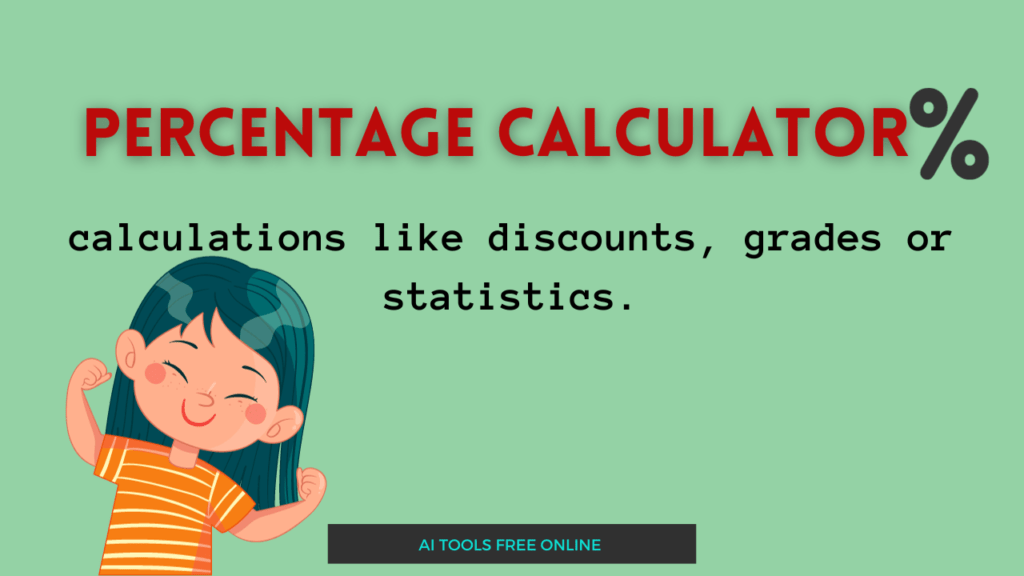Percentage Calculator How it Works:
- Input: Users provide a total number and a percentage.
- Calculation: The tool multiplies the total number by the percentage divided by 100.
- Click: Users click the “Calculate” button.
- Result: The calculated percentage is displayed. Use it for various percentage-based calculations like discounts, grades, or statistics.
Percentage Calculator
Toolkits As Per Your Needs

Percentage Calculator: Your Comprehensive Guide to Percentage Calculations
In a world driven by numbers, percentages play a pivotal role in various fields, from finance to statistics and beyond. Whether you’re a student needing to calculate grades, a business owner determining discounts, or a data analyst interpreting trends, understanding percentages is crucial. This comprehensive guide introduces you to the Percentage Calculator, a versatile tool designed to simplify percentage-related calculations.
Understanding Percentages
Prior to diving into the tool’s functionalities, accepting the idea of percentages is fundamental. A percentage addresses an extent or part of an entire, regularly communicated as a hundredth part. It is used to quantify relative quantities, making it easier to analyze, compare, and interpret data.
The Percentage Calculator Tool
The percentage calculator is an internet based utility that engages users to play out an extensive variety of percentage related calculations rapidly and accurately. Whether you really want to calculate percentage change, percentage difference, or just decide a percentage of a number, this tool takes care of you. Let’s explore how it works and its key features.
The Percentage Calculator is a versatile tool that addresses various common scenarios:
Why Choose the Percentage Calculator?
- Accuracy: The tool performs calculations with precision, eliminating the risk of human error.
- Speed: Obtain results instantly, saving time and effort in manual calculations.
- Versatility: Address various percentage-related scenarios with a single tool.
- Education: Ideal for students learning about percentages and their applications.
- Business: Streamline business operations with efficient discount and profit margin calculations.
- Finance: Analyze financial data, including investments and savings.
- Statistics: Track changes and trends in data sets with ease.
Start Calculating with Confidence
In a world where percentages influence decisions, having a reliable tool at your disposal is invaluable. The Percentage Calculator simplifies complex calculations, ensuring accuracy and efficiency in various domains. Whether you’re a student, professional, or business owner, this tool equips you to handle percentage-related tasks effortlessly.
Embrace the power of percentages and make informed decisions. Try the Percentage Calculator today and unlock a world of numerical possibilities.
Popular Tools
- Age Calculator
- Word Count
- Bad & Toxic Backlink Checker
- Link Analysis Tool
- QR Code Generator
- File Downloader
- Internet Speed Test
- Secure Password Generator
- What is my IP
- Audio Recorder
- Text To Speech Converter
- Background Remover
- Screen Recording
- Image Compressor
- Image Resizer
- Drawing Canvas
- Notepad, Create Notes
- Typing Speed Test
- Pie Chart Maker
- Fancy Text Generator
- Website Speed Test
- Digital Signature
FAQ's
How to calculate percentage?
To calculate a percentage, divide the part by the whole and multiply by 100. Formula: (Part / Whole) * 100.
How do you find 20% of 50?
To find 20% of 50, multiply 50 by 0.20 (20% as a decimal), resulting in 10.
How do you work out 20% of 100?
To work out 20% of 100, multiply 100 by 0.20, giving you 20.
What will be the 20% of 300?
To find 20% of 300, multiply 300 by 0.20, yielding 60.
How do you calculate a 5% increase?
To calculate a 5% increase, multiply the original number by 1.05.
How do you find the original number from a percentage increase?
To find the original number from a percentage increase, divide the increased value by (1 + percentage increase as a decimal).
How to calculate percent change?
To calculate percent change, subtract the old value from the new value, divide by the old value, and multiply by 100.
How to calculate percent change in mass?
Calculate percent change in mass using the formula: [(New Mass - Old Mass) / Old Mass] * 100.
How to calculate percentage change in price?
To calculate percentage change in price, use: [(New Price - Old Price) / Old Price] * 100.
How to find 1 unit percent change?
To find a 1 unit percent change, divide the change in value by the original value.
How to find a percentage of a number?
To find a percentage of a number, multiply the number by the percentage as a decimal.
How to find the percentage of two numbers?
Divide one number by the other, multiply by 100 to find the percentage.
How to increase a number by a percent?
Multiply the number by (1 + the percentage increase as a decimal).
What method do you use to calculate the percent change?
Use the formula [(New Value - Old Value) / Old Value] * 100 to calculate percent change.
Why is it better to calculate percentage change?
Calculating percentage change helps in assessing relative differences, making it easier to compare data and track trends.
